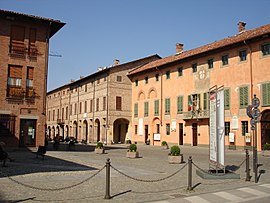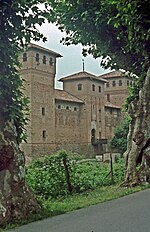Cherasco
| Cherasco | ||
|---|---|---|

|
|
|
| Country | Italy | |
| region | Piedmont | |
| province | Cuneo (CN) | |
| Coordinates | 44 ° 39 ' N , 7 ° 52' E | |
| height | 288 m slm | |
| surface | 81 km² | |
| Residents | 9,368 (Dec. 31, 2019) | |
| Population density | 116 inhabitants / km² | |
| Post Code | 12062 | |
| prefix | 0172 | |
| ISTAT number | 004067 | |
| Popular name | Cheraschesi | |
| Patron saint | Cristo Risorto | |
| Website | Cherasco | |
 Municipio e piazza antistante |
||
Cherasco ( Piedmontese Cherasch ) is an Italian commune with 9,368 inhabitants (as of December 31, 2019) in the province of Cuneo (CN) in the Piedmont region . In Cherasco, vines are grown for Dolcetto d'Alba , a red wine with DOC status. Cherasco is the holder of the Bandiera Arancione of the TCI .
Location and dates
The place is at an altitude of 288 m above sea level. The municipality covers an area of 81 km².
The municipality consists of the districts of Roreto, Bricco de 'Faule, Veglia, Cappellazzo, San Bartolomeo, San Giovanni and Sant'Antonino. The neighboring municipalities are Bra , Cervere , La Morra , Marene , Narzole and Salmour . The patron saint of the place is Cristo Risorto .
history
Cherasco came into being at the will of Manfredi Lancia in 1243, which belongs to a cadet branch of the Aleramide dynasty. Already in Roman times there was a place called Clerascum , and next to this the imperial vicar Lancia wanted to build a new village. Cherasco soon fell into the hands of the opposing party, the Guelphs of Charles I of Naples.
In 1277 Cherasco, together with Alba , Asti and Chieri , returned to the Ghibellines as a free and independent community in the dark times of the community struggle. In 1303 the city had to give its autonomy to the Anjou and then, in 1347, to Amadeus VI. , Count of Savoy.
After a bloody siege in 1348 the Savoia were expelled and Luchino Visconti became the master of the community, who had one of his castles built there. After it had passed into the trousseau of Valentina Visconti , it was given to the French and it was not until 1529 that the Savoia were able to win it back.
A new period of prosperity began in 1559. The city was fortified with walls designed by Ascanio Vittozzi . When the plague arrived in 1630, Cherasco was the residence of the royal court. After the danger was averted, the Belvedere Arch (Arco del Belvedere), one of the city symbols, was built in 1647. On April 6 and June 19, 1631 were by the agents of Viktor Amadeus I of Savoy, Emperor Ferdinand II and King Louis XIII. France signed two peace treaties. With this Peace of Cherasco ended the Mantuan War of Succession (1628-1631).
On the morning of April 23, 1796, the French besieged Cherasco during Napoléon's Italian campaign , which surrendered in the evening with the request for an armistice on the part of General Colli, the commander of the Piedmontese. Napoleon Bonaparte moved into the city and settled down. The Corsican general enforced the Cherasco armistice , even though he stated that he was not allowed to act for the Directory . With the armistice, the geography of the Sabaudian possessions was reorganized. The armistice was signed by Viktor Amadeus III. approved on April 28th.
Attractions
Castles
- the Visconti castle from the 14th century
Churches
- the Church of Saint Augustine
- the church of San Pietro from the middle of the 13th century. Romanesque facade and campanile , the interior baroque . In the campanile there is a fresco of a crucifixion from 1488.
- the church of Saint Martin from the 13th century - 14th century
- the pilgrimage site of the Madonna del Popolo (Holy Mother of God of the People)
Museums
- the Museo Civico (City Museum) "Giovanni Battista Adriani"
- the Museo della Magia (Magic Museum)
Palazzo Salmatoris
The palazzo is located in the city center and takes its name from the local noble Giovanni di Audino Salmatoris, who had it built in 1620. It is also known as the "Peace Palace" (Palazzo della Pace) because it witnessed many historical events in the city; These include the keeping of the Turin shroud in 1706 and the signing of the armistice between Napoleon and the Sabaudian Empire in 1796. It has already undergone a number of restoration measures in the past centuries and today it is an important cultural center that hosts international art exhibitions.
synagogue
The synagogue was built in the 18th century within the city's old ghetto (formed in 1725 and abolished by Carl Albert in 1848). It is a testimony that the Hebrew culture was there, which goes back to an even earlier time. It consists of a small, square hall, with walls decorated with Hebrew inscriptions and carved furniture.
Visconti castle
Founded in 1348 by Lodovico Visconti.
Sponsored cities
The city has the following sponsored cities:
-
 Kirjat Gat , Israel
Kirjat Gat , Israel
-
 Villars-sur-Var , France
Villars-sur-Var , France
-
 Möckmühl , Germany , since 2001
Möckmühl , Germany , since 2001 -
 Piliscsaba , Hungary , since 2005
Piliscsaba , Hungary , since 2005 -
 Cefa , Romania , since 2006
Cefa , Romania , since 2006
The city is also a member of the Federation of European Napoleonic Cities .
Web links
- Website of the municipality of Cherasco
- Information about Cherasco
- News about Cherasco
- Website of the Roero and surroundings
Individual evidence
- ↑ Statistiche demografiche ISTAT. Monthly population statistics of the Istituto Nazionale di Statistica , as of December 31 of 2019.
- ↑ Bandiera Arancione. In: Bandierearancioni.it. Retrieved April 19, 2018 (Italian).
- ↑ http://www.museodellamagia.it/index.php/it/info/biglietteria




